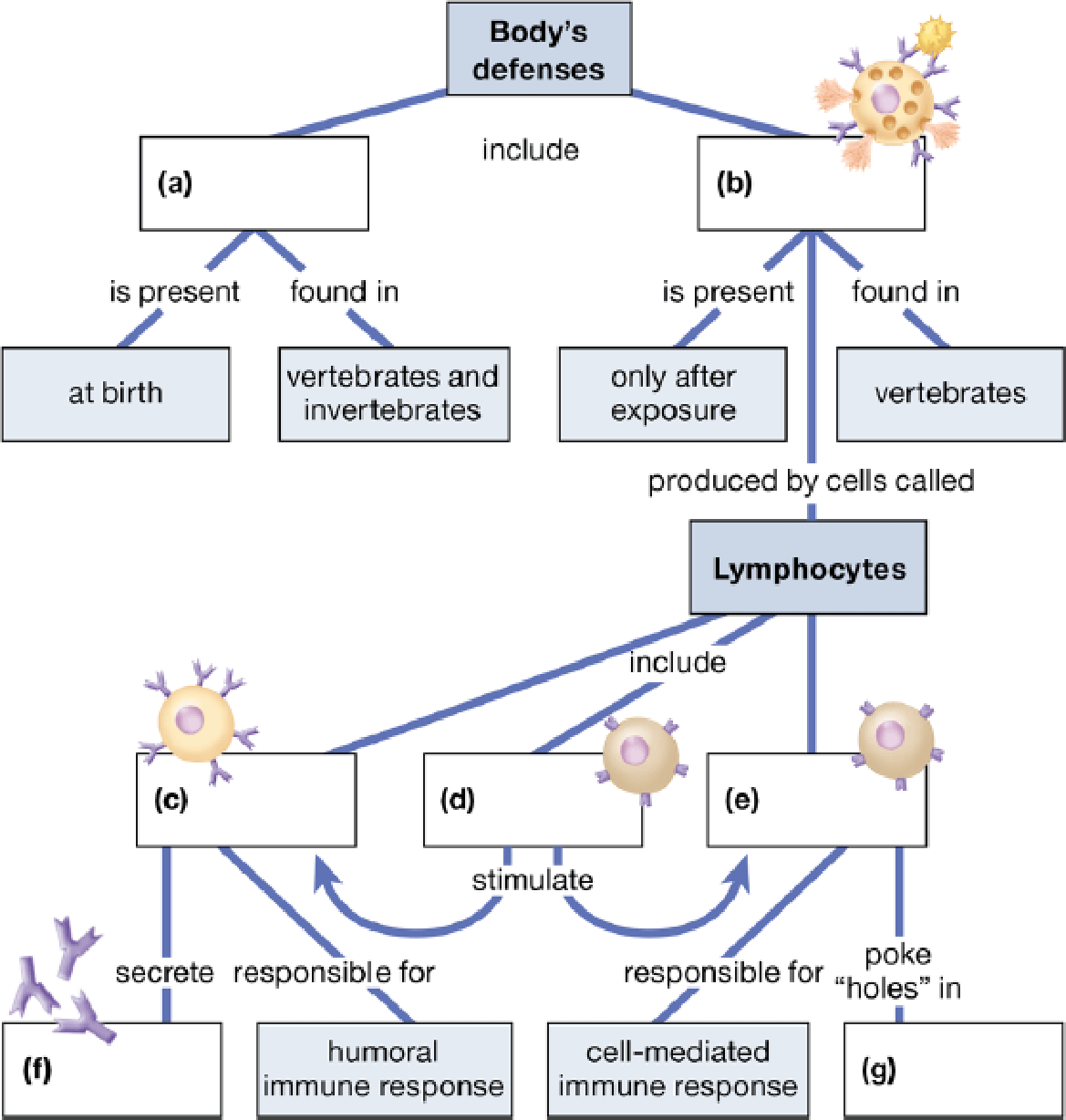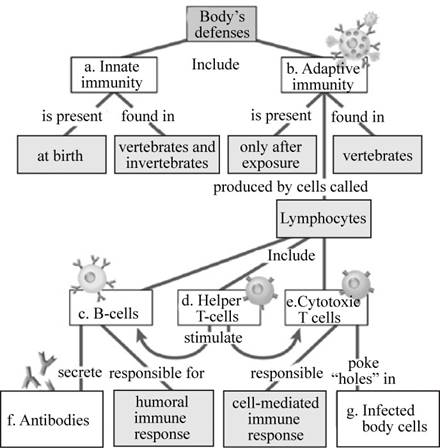
Concept explainers
Complete this concept map to summarize the key concepts concerning the body’s defenses.

To complete: The given concept map and to summarize the key concepts concerning body’s defense.
Introduction:
The immune system of the human body is divided into two main branches, namely the innate immunity and the adaptive immunity. Innate or the body’s first defense mechanism is present since birth and this defense mechanism are non-specific, which means it acts as a barrier in for every foreign body irrespective of its structure. Adaptive immunity of the body comes in later stages, when the body is introduced to pathogens. It is a specific type of defense mechanism.
Answer to Problem 1CC
Pictorial representation: A concept map explaining immune defense mechanisms of body is presented in Fig.1.

Fig. 1: Map depicting the concept of body’s defenses
Explanation of Solution
a)
Correct answer: Innate immunity.
Explanation:
Innate immunity is the immunity present in the body since birththat helps in protecting the body from infection. Hence the correct answer is innate immunity.
(b)
Correct answer: Adaptive immunity.
Explanation:
Adaptive immunity is the immunity that is acquired by the body when the body comes in contact with the foreign agent. Hence the correct answer is adaptive immunity.
(c)
Correct answer: B-cells.
Explanation:
B-cells are the immune cells that help in the protecting the body from infection and is a part of the humoral immunity. Hence the correct answer is B-cells.
(d)
Correct answer: Helper T-cells.
Explanation:
Helper T-cells helps in the recognizing the foreign antigen and instigate the release of antibodies. Hence the correct answer is helper T-cells
(e)
Correct answer: Cytotoxic T cells.
Explanation:
Cytotoxic T-cells help in neutralizing the antigen carrying cell by attaching to it and releasing degenerative enzymes. Hence the correct answer is cytotoxic T cells.
(f)
Correct answer: Antibodies.
Explanation:
Antibodies are protein molecules that help in the recognizing foreign antigen and eliciting an immune response. Hence the correct answer is antibodies.
(g)
Correct answer: Infected body cells.
Explanation:
Infected body cells are the host’s cells that are penetrated by the infectious agent. Hence the correct answer is infected body cells.
Want to see more full solutions like this?
Chapter 24 Solutions
CAMPBELL BIOLOGY:CONCEPTS+CONNECTIONS
- Noggin mutation: The mouse, one of the phenotypic consequences of Noggin mutationis mispatterning of the spinal cord, in the posterior region of the mouse embryo, suchthat in the hindlimb region the more ventral fates are lost, and the dorsal Pax3 domain isexpanded. (this experiment is not in the lectures).a. Hypothesis for why: What would be your hypothesis for why the ventral fatesare lost and dorsal fates expanded? Include in your answer the words notochord,BMP, SHH and either (or both of) surface ectoderm or lateral plate mesodermarrow_forwardNot part of a graded assignment, from a past midtermarrow_forwardNot part of a graded assignment, from a past midtermarrow_forward
- please helparrow_forwardWhat does the heavy dark line along collecting duct tell us about water reabsorption in this individual at this time? What does the heavy dark line along collecting duct tell us about ADH secretion in this individual at this time?arrow_forwardBiology grade 10 study guidearrow_forward
 Human Heredity: Principles and Issues (MindTap Co...BiologyISBN:9781305251052Author:Michael CummingsPublisher:Cengage Learning
Human Heredity: Principles and Issues (MindTap Co...BiologyISBN:9781305251052Author:Michael CummingsPublisher:Cengage Learning Human Physiology: From Cells to Systems (MindTap ...BiologyISBN:9781285866932Author:Lauralee SherwoodPublisher:Cengage Learning
Human Physiology: From Cells to Systems (MindTap ...BiologyISBN:9781285866932Author:Lauralee SherwoodPublisher:Cengage Learning Biology: The Dynamic Science (MindTap Course List)BiologyISBN:9781305389892Author:Peter J. Russell, Paul E. Hertz, Beverly McMillanPublisher:Cengage Learning
Biology: The Dynamic Science (MindTap Course List)BiologyISBN:9781305389892Author:Peter J. Russell, Paul E. Hertz, Beverly McMillanPublisher:Cengage Learning Human Biology (MindTap Course List)BiologyISBN:9781305112100Author:Cecie Starr, Beverly McMillanPublisher:Cengage Learning
Human Biology (MindTap Course List)BiologyISBN:9781305112100Author:Cecie Starr, Beverly McMillanPublisher:Cengage Learning Medical Terminology for Health Professions, Spira...Health & NutritionISBN:9781305634350Author:Ann Ehrlich, Carol L. Schroeder, Laura Ehrlich, Katrina A. SchroederPublisher:Cengage Learning
Medical Terminology for Health Professions, Spira...Health & NutritionISBN:9781305634350Author:Ann Ehrlich, Carol L. Schroeder, Laura Ehrlich, Katrina A. SchroederPublisher:Cengage Learning





